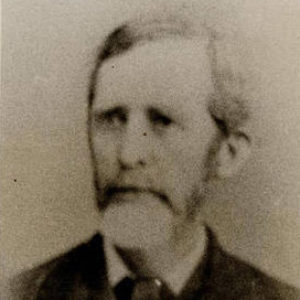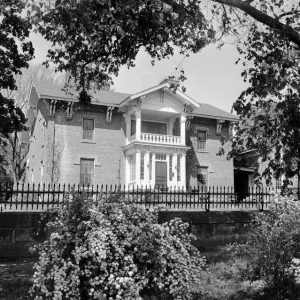calsfoundation@cals.org
Lafayette Gregg (1825–1891)
One of the most enigmatic, if relatively unknown, figures in Arkansas history is Judge Lafayette Gregg. Gregg was a member of one of the pioneering families in northwest Arkansas and was involved in one way or another in nearly every major historical event in Arkansas history that happened during his lifetime. Although most remembered as an instrumental figure in the location of Arkansas Industrial University—later the University of Arkansas (UA) in Fayetteville (Washington County)—in northwest Arkansas, he was also a banker, lawyer, state representative, Civil War veteran, and Arkansas Supreme Court justice. At the time of his death, Gregg was in service to Arkansas helping prepare the state’s exhibition for the 1893 World’s Fair.
Lafayette Gregg was born on February 6, 1825, in Moulton, Alabama, one of six children of Henry and Mary Gregg. His father was a War of 1812 soldier and early pioneer in northwest Arkansas. Gregg arrived in Washington County at the age of ten and received his early education at the Ozark Academy. Following a short stay at the academy, Gregg found a place in the law offices of W. D. Reagan of Fayetteville and went on to gain admission to the bar. In December 1852, he married Mary Shrave. They had three sons and a daughter.
As a young lawyer, Gregg served a term as a state representative in 1854, and following the end of his term, he served as a prosecuting attorney for the Fourth Circuit, a post he held until 1861. A Southern Unionist, Gregg resigned his position with the circuit court to serve as a commander in the Fourth Arkansas Cavalry (Federal), although his involvement in any major military action during the war remains unknown. Following the war, Gregg continued to practice law and, in 1864, served a year-long term as chancellor of the chancery circuit court for Pulaski County.
Arkansas Industrial University was located in Fayetteville largely due to the efforts of Gregg. Through the influence of Gregg and William McIlroy, the city and county were able to secure $100,000 in bonds for the establishment of the school. This was during the financial depression that followed the Civil War and at a time when Fayetteville lacked even a railroad. Gregg also served on the board of trustees from 1874 to 1883 for the university and personally oversaw the construction of the architectural centerpiece of the Fayetteville campus, Old Main, known then as University Hall.
Following the war and a term as chancellor of Pulaski County, Gregg served the state Supreme Court as an associate justice, remaining on the bench until 1874. In 1889, Gregg served as the Republican candidate for governor but lost to the incumbent, Simon P. Hughes Jr. Gregg returned to his private life and, in 1889, became the president of the Bank of Fayetteville. On October 21, 1891, he was named chair of the state banking association. He was also appointed to serve as a state commissioner to represent Arkansas during the “World’s Columbian Exposition” (the World’s Fair of Chicago) in 1893. However, two years before the fair, Gregg became seriously ill, dying on November 1, 1891.
Out of respect, the circuit court adjourned, and the university and all banks and businesses closed on November 3, the day of Gregg’s funeral. He was buried with honors in Evergreen Cemetery in Fayetteville. His home, now known as the Gregg House, and the monument to the Gregg family in Evergreen Cemetery remain landmarks in the city of Fayetteville.
For additional information:
“Judge Gregg Dying.” Arkansas Gazette. November 1, 1891, p.1.
“Judge Lafayette Gregg (Nov. 1, 1891).” Arkansas Democrat. November 2, 1891, p. 1.
Gregg Family Papers. Special Collections. University of Arkansas Libraries, Fayetteville, Arkansas.
Stafford, L. Scott. “Supreme Court Justice Lafayette Gregg.” Arkansas Lawyer 43 (Fall 2008): 24.
James N. Wilhelm
University of Arkansas, Fayetteville
 Education, Higher
Education, Higher Lafayette Gregg
Lafayette Gregg  Lafayette Gregg Home
Lafayette Gregg Home 




Comments
No comments on this entry yet.